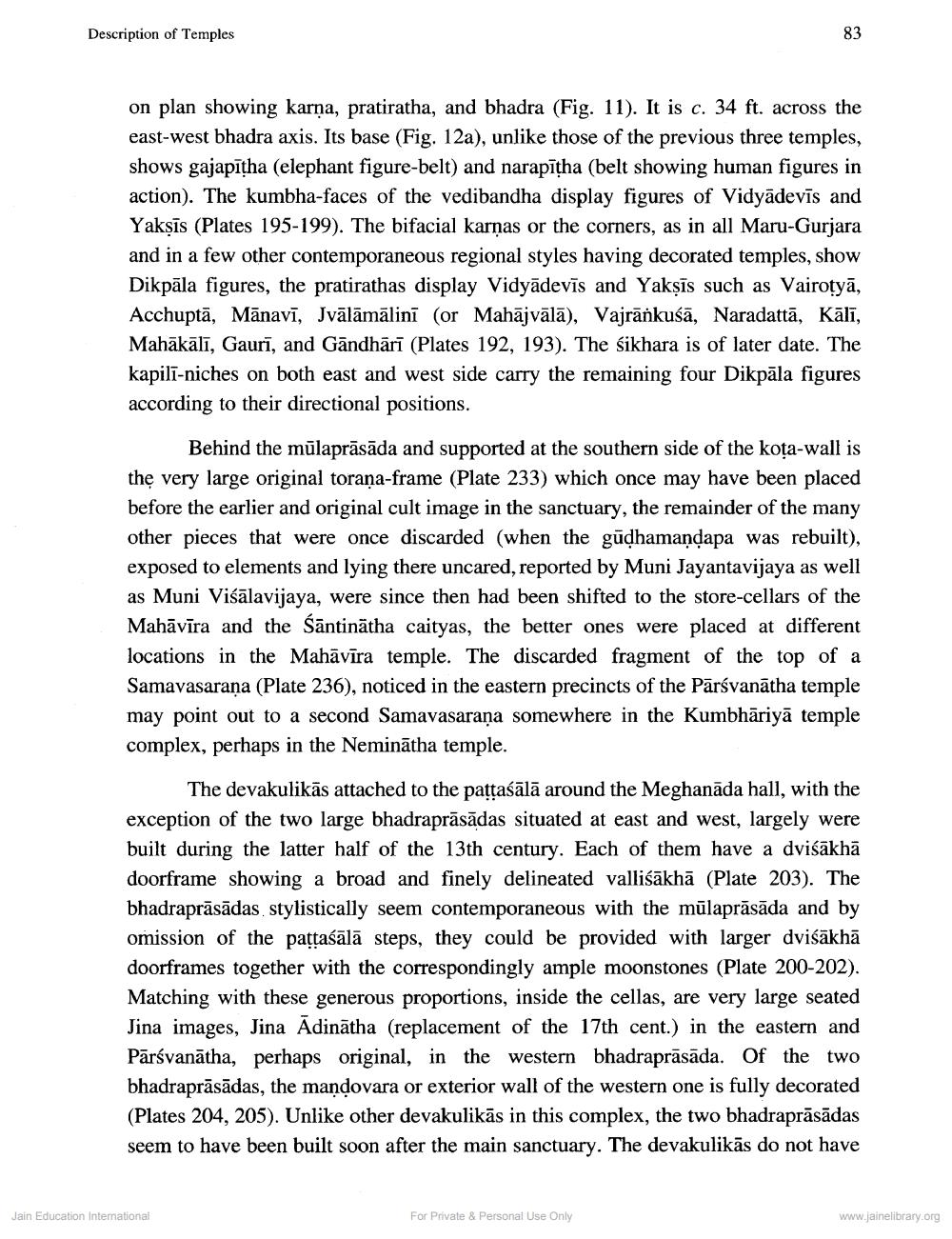________________
Description of Temples
on plan showing karma, pratiratha, and bhadra (Fig. 11). It is c. 34 ft. across the east-west bhadra axis. Its base (Fig. 12a), unlike those of the previous three temples, shows gajapītha (elephant figure-belt) and narapītha (belt showing human figures in action). The kumbha-faces of the vedibandha display figures of Vidyādevīs and Yakṣīs (Plates 195-199). The bifacial karņas or the corners, as in all Maru-Gurjara and in a few other contemporaneous regional styles having decorated temples, show Dikpāla figures, the pratirathas display Vidyādevīs and Yakṣīs such as Vairotyā, Acchuptā, Mānavī, Jvālāmālini (or Mahājvālā), Vajrankuśā, Naradattā, Kālī, Mahākālī, Gaurī, and Gāndhārī (Plates 192, 193). The sikhara is of later date. The kapilī-niches on both east and west side carry the remaining four Dikpāla figures according to their directional positions.
Behind the mūlaprāsāda and supported at the southern side of the kota-wall is the very large original torana-frame (Plate 233) which once may have been placed before the earlier and original cult image in the sanctuary, the remainder of the many other pieces that were once discarded (when the gūdhamandapa was rebuilt), exposed to elements and lying there uncared, reported by Muni Jayantavijaya as well as Muni Viśālavijaya, were since then had been shifted to the store-cellars of the Mahāvīra and the Sāntinātha caityas, the better ones were placed at different locations in the Mahāvīra temple. The discarded fragment of the top of a Samavasarana (Plate 236), noticed in the eastern precincts of the Pārsvanātha temple may point out to a second Samavasaraṇa somewhere in the Kumbhāriyā temple complex, perhaps in the Neminātha temple.
The devakulikās attached to the pattaśālā around the Meghanāda hall, with the exception of the two large bhadraprāsādas situated at east and west, largely were built during the latter half of the 13th century. Each of them have a dviśākhā doorframe showing a broad and finely delineated valliśākhā (Plate 203). The bhadraprāsādas stylistically seem contemporaneous with the mūlaprāsāda and by omission of the pattaśālā steps, they could be provided with larger dviśākhā doorframes together with the correspondingly ample moonstones (Plate 200-202). Matching with these generous proportions, inside the cellas, are very large seated Jina images, Jina Adinātha (replacement of the 17th cent.) in the eastern and Pārsvanātha, perhaps original, in the western bhadraprāsāda. Of the two bhadraprāsādas, the mandovara or exterior wall of the western one is fully decorated (Plates 204, 205). Unlike other devakulikās in this complex, the two bhadraprāsādas seem to have been built soon after the main sanctuary. The devakulikās do not have
Jain Education International
For Private & Personal Use Only
www.jainelibrary.org




